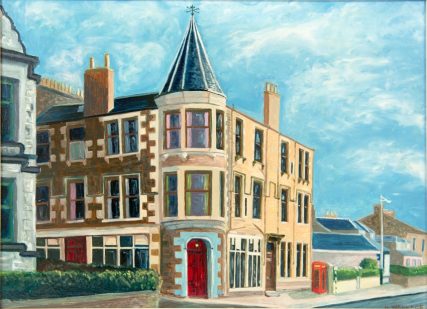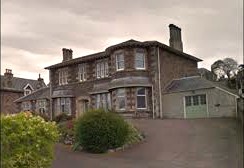Newport Inn
The Newport Inn was built by the first Mr John Berry in 1806 to replace the earlier one which had been erected by the Dundee Guildry on the site of the later Trinity Church. The new inn was a convenient and popular coaching inn, but even after the coaching days were over the inn continued to prosper. For most of the nineteenth century the inn was the place to meet, and according to local news reports, it was regularly used for meetings of the curling club, the swimming club, the rowing club and the proprietors of the Newport railway to name but a few. Frequent mention is made in the local press of sumptuous meals provided, and lavish entertainment in the beautifully decorated rear hall. In the 1890s it was greatly enlarged to the side and rear. There was of course extensive courtyard area and stabling accommodation to the rear of the inn, but this was all demolished by the mid-1960s. By the early 2000s the hotel had became very down-at-heel, but by 2020 it had undergone a complete refurbishment and had become widely known for its top quality restaurant The Newport.
Woodhaven Inn
Because there was a ferry at Woodhaven, there was also an inn there with a farm and brewery on the opposite side of the road connected to it. The brewery produced strong ale and table beer. Like other buildings round about, the inn belonged to the Stewart family of St Fort estate. The inn also offered a horse-hiring service: the horses would be used by the coaches and also by individual travellers. Mr Grant, the tenant in the 1860s, was most distressed when asked to vacate the premises in 1873 in favour of officers from the Mars training ship. This would create great hardship for his family of seven children which included a boy with a recently amputated leg! His beseeching letter and pleas were to no avail, and the building was occupied by the Mars captain and his family until the ship’s departure in 1929. During that time it became known as Mars Cottage.
Seymour Hotel
The Seymour hotel, now Riverview Lodge care home on Tay Street, operated as a hotel from 1949 until 1989, but was built in 1898 as a private house. Seymour was built by John Adam St Quentin Leng, son of Sir John. His family lived at Seymour for almost fifty years. Tragically in 1945 one of his sons committed suicide there, and this tragic event probably hastened the sale of the house four years later. As a hotel, the Seymour was hugely popular with both locals and visitors.
Seymour was built at the same time as Highfield on Kirk Road, now better known as the Leng Home. Highfield was built by Sir John’s second son William, and was later re-named Waterstone House. After William’s death in 1953 that house was gifted to the council for use as a home for the elderly.
Maryton Inn
When Mr Dalgleish of Scotscraig founded the village of Maryton in the 1820s, he also established the Maryton Inn. This building is now known as Bay House, at 12 Tay Street. The houses in Union Street at the rear of Bay House were the stables for the inn, and no doubt the extensive cellar under the building was an excellent storage area. The only known tenant of the inn was Mr Thomas Honeyman. Unfortunately the main route to the ferry pier was not along Tay Street but down Cupar Road. Being situated just too far from the main thoroughfare, the Maryton Inn was doomed to failure. Mr Honeyman fell into arrears with his rent, and was eventually served with a process of eviction. Both the inn and the stables to the rear were converted to houses in the 1830s. Bay House was in fact used for some time as a manse for the first minister of St Fillan’s Church, which stood further up William Street until being demolished in 1979. The manse for this church was eventually built half-way up Gowrie Street, probably around 1850.
Royal Hotel
Half-way along Tay Street was the Royal Hotel, built in the late 1870s, on the land where the present Royal Buildings block of flats now stands. At first an excellent hotel, its reputation sharply deteriorated until the hotel licence was withdrawn, and the buildings were rented out mainly as dwelling houses, but also as businesses, shops and café. The buildings were also sometimes referred to as Turnbull’s Buildings, after the man who built them in 1877. These Royal Buildings were demolished in the 1970s, and in the foundations were found a glass carboy containing newspapers from 1877 and a memorandum written and signed by John Turnbull.
Craighead House Hotel
Not far from the Seymour, on the other side of Tay Street, is Craighead House at the bottom of Bank Street. This property also operated briefly as a hotel, only for about two years in the mid-1930s. On the small information card issued by the hotel, it can be seen that Craighead House had rather a prestigious telephone number – Newport 1!












No Comments
Add a comment about this page